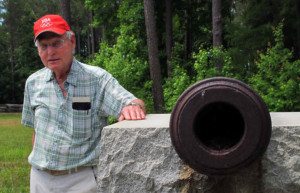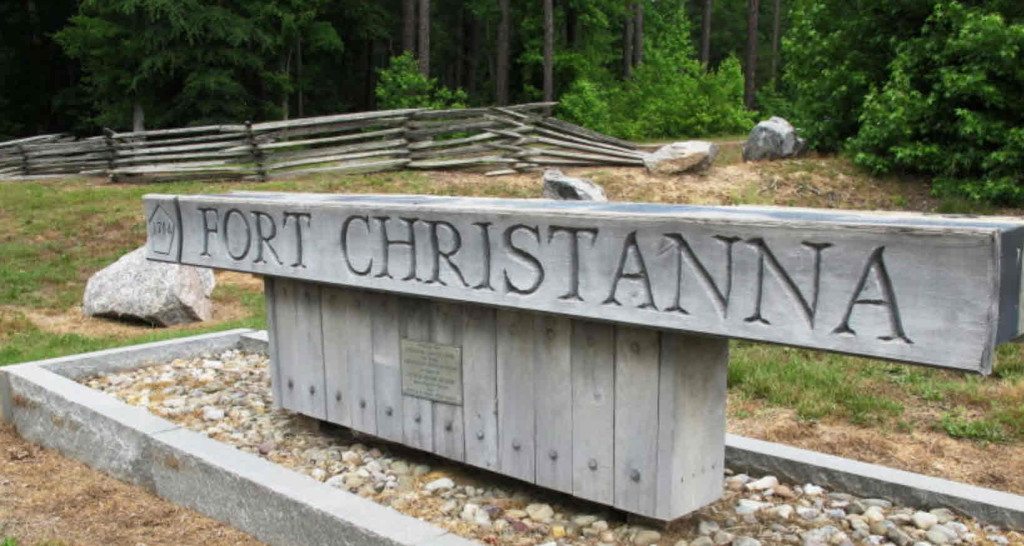In 1714, Governor Spotswood built TWO pentagonal forts to secure the frontiers of Virginia – Fort Christanna and Fort Germanna.
Archaeologists at Fort Christanna have discovered all five corners of their pentagon, and have shown that each was 300 feet long.
Since both forts were built at the direction of Governor Spotswood, it’s a safe assumption that military surveyors and their work crews used the same design and that Fort Germanna’s palisade walls were also 300 feet long.
This research has helped our team in the field over the last few weeks as we have explored the Fort Germanna archaeological site with ground-penetrating radar.
Brunswick fort an ‘uncut gem’ of history
(Richmond Times-Disptach, June 2014)
LAWRENCEVILLE — The first time he visited the site of Fort Christanna, Nat Neblett was just a boy, the year was 1942, and the historic place was thick with weeds and trees.
 “It was so grown up that you had to fan out to find the cannon,” Neblett said of the site’s signature piece, an old cannon mounted upon a concrete monument. “When somebody found it, they said, ‘It’s over here!’”
“It was so grown up that you had to fan out to find the cannon,” Neblett said of the site’s signature piece, an old cannon mounted upon a concrete monument. “When somebody found it, they said, ‘It’s over here!’”
The site on a bluff above the Meherrin River is much less wild today, trimmed and tamed by a community wanting to tell the story of a fort that is not particularly well-known beyond the boundaries of Brunswick County.
This Saturday at 2 p.m., the 300th anniversary of the founding of the fort — the westernmost outpost of the British Empire in the Virginia Colony during its short existence — will be commemorated with an event at the site, south of Lawrenceville on Fort Hill Road, just off Christanna Highway, which is state Route 46. The public is invited.
“It’s not Jamestown, but it’s an important part of Brunswick County’s history,” said Bobby Conner of the Brunswick County/Lake Gaston Tourism Association.
Fort Christanna was a five-sided log structure established by Gov. Alexander Spotswood in 1714 as a trading center and a military fort in the middle of a 36-square-mile tract of land to serve as protection on the frontier for traders and friendly but vulnerable Indian tribes. The name was a nod to the Englishmen’s religion as well as Great Britain’s Queen Anne.
An Indian town was set up outside the fort for the tribes that had signed treaties with the English and traded with them, but were at risk of attack and enslavement by larger tribes.
Within the fort, Spotswood set up a school where Indian children were taught Christianity and English.
In correspondence, Spotswood referred to the children as “hostages,” a commonplace term in that era to describe a practice of holding children to ensure cooperation among adults, which today, of course, makes your skin crawl.
“The Fort Christanna experience was a mixed one for Indian people,” said John Kincheloe, head of media services at Meredith College in Raleigh, N.C., who has researched and written extensively on American Indian history and specifically those tribes involved with the fort. He has served as a historical consultant for the Fort Christanna Historical Site.
“In certain aspects, it provided a way for smaller tribal groups to survive in a very difficult and violent time,” said Kincheloe, who grew up in Richmond and graduated from the University of Richmond. “In other ways, it was a very difficult time for Indian people because of the way their traditional cultures came under assault and because of the way their children were used at the Indian school.”
However, the bottom line is this: It’s history. For good or ill. You don’t necessarily have to like the story, but you ought to know it, complicated as it is.
And the people of Brunswick have gone to a lot of effort to preserve this place.
Kincheloe said in a phone interview he considers the fort “an uncut gem of history” that many people remain unaware of.
Fort Christanna existed only a few years. The British ended their support for the fort and abandoned it.
Indians likely used it for a while, but by 1728 it was reported to be deserted. No remnants of the fort are visible.
Archaeological work has determined the exact site of the fort, and the outline of the fort — the five palisade walls each a football field in length — is marked by a gravel walking path. Interpretive signs tell the story along the way.
Last week I drove to the fort site — a mile down an unpaved road off the main highway — and walked the length of the fort’s perimeter with a group of local residents, including Nancy Avery, Gay Neale and Neblett, all members of the Fort Christanna site development committee.
We went from corner to corner, where bastions once stood, on the path that today is a walk through the woods. Trees block the view to the nearby Meherrin, but downhill trails lead to the river.
“The river is perfectly beautiful, absolutely pristine,” said Neblett, chairman of the committee. “It probably looks right now just the way it did 300 years ago.”
Besides the walkway and signs, the site features an outdoor classroom of concrete seats made to look like upright logs.
The cannon, though on a newer stone pedestal, is still there.
Fort Christanna is on the Civil Rights in Education Heritage Trail and also is a stop on the Virginia Birding and Wildlife Trail.
Future development could include recreational trails, greater access to the river and more educational programs.
“The potential for this place is overwhelming,” Avery said.
One missing piece to the story of Fort Christanna is the exact location of the nearby Indian town where the Saponie tribes lived.
Kincheloe said at least two archaeologists are interested in pursuing a project that would pinpoint the location of the town, which could unearth artifacts and something more.
“Because the story of Christanna has been told largely from an English point of view, it’s been difficult to get the full significance of the fort,” said Kincheloe, who recently completed a manuscript about the Indian people at Christanna. “Many of us are looking forward to a time when we can excavate the site … so we can tell the side of the story from the Indian people.”
wlohmann@timesdispatch.com, (804) 649-6639
More Information
Fort Christanna (Wikipedia)
Fort Christanna Historical Site (Brunswick County)

